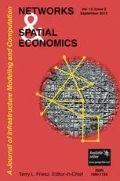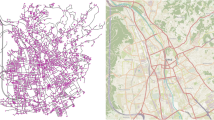Abstract
There have been different approaches which have been proposed to understand the mechanism of traffic congestion propagation. In this paper, we use the cell transmission model and apply it to simulate the formation and dissipation of traffic jams at the microscopic level. In particular, our model focuses on jam propagation and dissipation in two-way rectangular grid networks. In the model, the downstream exit of the link is channelized to represent the interactions of vehicles in different directions. We have used traffic jam size and congestion delay to measure jam growth and dispersal. Numerical examples exploring the impact of model parameters on jam growth and congestion delay are provided. The simulation results show that there are two strategies to minimize jam size and reduce time for jam dissipation: (1) reduce the length of channelized area and, (2) allocate the stopline widths for all directions in the same ratio as the demands. Furthermore, we obtain some new results about gridlock and discuss the effect of incident position and link length on jam propagation.












Similar content being viewed by others
References
Daganzo CF (1994) The cell transmission model: a simple dynamic representation of highway traffic. Transp Res Part B 28(4):269–287
Daganzo CF (1995) The cell transmission model, part II: network traffic. Transp Res Part B 29(2):79–93
Daganzo CF, Laval JA (2005) Moving bottlenecks: a numerical method that converges in flows. Transp Res Part B 39(10):855–863
Gao ZY, Song YF (2002) A reserve capacity model of optimal signal control with user-equilibrium route choice. Transp Res Part B 36(4):313–323
Gentile G, Meschini L, Papola N (2007) Spillback congestion in dynamic traffic assignment: a macroscopic flow model with time-varying bottlenecks. Transp Res Part B 41(10):1114–1138
Jiang R, Wu QS, Zhu ZJ (2001) A new dynamics model for traffic flow. Chin Sci Bull 46(1):345–349
Lam WHK, Yin Y (2001) An activity-based time dependent traffic assignment model. Transp Res Part B 35(6):549–574
Lian AP, Gao ZY, Long JC (2007) A dynamic user optimal assignment problem based on link variables of the cell transmission model. Acta Automatica Sin 33(8):852–859 (in Chinese)
Lighthill MH, Whitham GB (1955) On kinematics wave: II a theory of traffic flow on long crowed roads. Proc R Soc Lond A 22:317–345
Lo HK (1999) A novel traffic signal control formulation. Transp Res Part A 33(5):433–448
Lo HK (2001) A cell-based traffic control formulation: strategies and benefits of dynamic timing plans. Transp Sci 35(2):149–164
Lo HK, Szeto WY (2002) A cell-based variational inequality formulation of the dynamic user optimal assignment problem. Transp Res Part B 36(5):421–443
Long JC, Gao ZY, Ren HL, Lian AP (2008) Urban traffic congestion propagation and bottleneck identification. Sci China F Inf Sci 55(7):948–964
Nagel K, Schreckenberg M (1992) A cellular automaton model for freeway traffic. J Phys I 2(12):2221–2228
Newell GF (1993) A simplified theory on kinematic wave in highway traffic, part I: general theory; part II: queuing at freeway bottlenecks; part III: multi-destination flows. Transp Res Part B 27(4):281–314
Ni DH, Leonard JD (2005) A simplified kinematic wave model at a merge bottleneck. Appl Math Model 29(11):1054–1072
Richards PI (1956) Shock waves on the highway. Oper Res 4:42–51
Roberg P (1954) Development and dispersal of area-wide traffic jams. Traffic Eng Control 35(6):379–386
Roberg P (1995) Distributed strategy for eliminating incident-based traffic jams from urban networks. Traffic Eng Control 36(6):348–355
Roberg P, Abbess CR (1998) Diagnosis and treatment of congestion problems in central urban areas. Eur J Oper Res 104(1):218–230
Roberg-Orenstein P, Abbess CR, Wright C (2007) Traffic jam simulation. J Maps v2007:107–121
Shang HY, Huang HJ, Gao ZY (2007) Locating the variable message signs by cell transmission model. Acta Phys Sin 56(8):4342–4347
Wright C, Roberg-Orenstein P (1999) Simple models for traffic jams and congestion control. Proc Inst Civ Eng Transp 135(3):123–130
Wright C, Roberg P (1998) The conceptual structure of traffic jams. Transp Policy 5:23–35
Ziliaskopoulos AK (2000) A linear programming model for the single destination system optimum dynamic traffic assignment problem. Transp Sci 34(1):37–49
Acknowledgements
This work is partially supported by National Basic Research Program of China (2006CB705500), National Natural Science Foundation of China (70631001, 70801004) and the Innovation Foundation of Science and Technology for Excellent Doctorial Candidate of Beijing Jiaotong University (48040).
Author information
Authors and Affiliations
Corresponding author
Appendix
Appendix
In this section, Daganzo’s CTM is extended to formulate three categories of cell inflow.
-
1)
Inflow of upstream cells
Inflow of upstream cells can be calculated by:
$$y_{a}^{i}(t)=min\left\{n_{a}^{i-1}(t), Q_{a}^{i}(t), w \left(N_{a}^{i}(t)-n_{a}^{i}(t)\right)/v\right\}, 1<i\leq\lambda-I$$(15)From Eq. (15), we have
$$y_{ab}^{i}(t)=\phi_{ab}y_{a}^{i}(t), 1<i\leq\lambda-I$$(16) -
2)
Inflow of downstream queues area
We define \({\widetilde{y}}_{ab}(t)\) as the up bound of inflow of downstream queues area for vehicles travelling from link a to link b. We have
$${\widetilde{y}}_{ab}(t)=min\left\{ \phi_{ab}n_{a}^{\lambda-I}(t), \alpha_{ab}Q_{a}^{\lambda-I+1}(t), w \left(\alpha_{ab}N_{a}^{\lambda-I+1}(t)-n_{ab}^{\lambda-I+1}(t)\right)/v \right\}$$(17)Because of interference between turning vehicles and ahead vehicles, the total inflow of channelized queues area can be formulated as follows
$$y_{a}^{\lambda-I+1}(t)=min_{b\in B_{m}}\left\{{\widetilde{y}}_{ab}(t)/\alpha_{ab}\right\}$$(18)Inflow of each direction can be calculated by Eq. (18), gives
$$y_{ab}^{\lambda-I+1}(t)=\phi_{ab}y_{a}^{\lambda-I+1}(t)$$(19)$$y_{ab}^{\lambda-I+1}(t)=\phi_{ab}y_{a}^{\lambda-I+1}(t)$$(20) -
3)
Inflow of channelized cells
$$y_{ab}^{i}(t)=min\left\{n_{ab}^{i-1}(t), \alpha_{ab}Q_{a}^{i}(t), w \left(\alpha_{ab}N_{a}^{i}(t)-n_{ab}^{i}(t)\right)/v\right\}, \lambda-I+1<i\leq\lambda$$(21)The total inflow of cell i can be calculated by Eq. (21), gives
$$y_{a}^{i}(t)=\sum\limits_{b\in B_{m}}y_{ab}^{i}(t), \lambda-I+1<i\leq\lambda$$(22)
Rights and permissions
About this article
Cite this article
Long, J., Gao, Z., Zhao, X. et al. Urban Traffic Jam Simulation Based on the Cell Transmission Model. Netw Spat Econ 11, 43–64 (2011). https://doi.org/10.1007/s11067-008-9080-9
Received:
Accepted:
Published:
Issue Date:
DOI: https://doi.org/10.1007/s11067-008-9080-9




